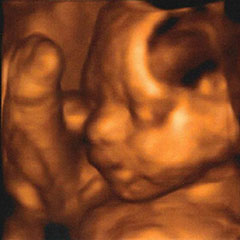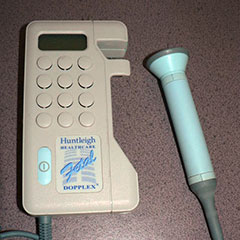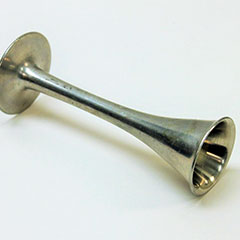The First Sound: the Heartbeat
The human heart starts to beat as early as the 21 st day of pregnancy. The embryo is then barely two to three millimetre long, the size of an apple seed. Its heart is shaped like a smooth tube. At this stage, it is already pumping blood throughout the baby’s body. During the following weeks, the heart keeps growing and developing to form its four ventricles.
Nowadays, it is possible to detect the fetal heartbeat as early as the fifth or sixth week of pregnancy thanks to the sonogram. This technique became widespread in the 1970’s. Before that, starting at the beginning of the 19 th century, the obstetric stethoscope was used to hear the baby’s heart. Similar to Laennec’s stethoscope, which consisted of a wooden cone with a metal plate at one end, the instrument was applied to the mother’s stomach to listen to her child’s heartbeat. The sound could only be perceived beyond the 18 th week of pregnancy.
Sonography: a Window into the Human Body
Based on the same principle as the sonar, the obstetric sonogram works by sending ultrasounds into the uterus. These sound waves reflect on the fetus, allowing us to study its organs, keep an eye on its growth, discover potential anomalies and determine its sex. On the sonogram image, the heartbeat is indicated by a flickering spot.
Ultrasounds were first used in the sailing world at the beginning of the 20 th century. They helped detect submarines during World War One, or locate icebergs. During the 1950’s, the technology entered the medical field with sonography equipment that could probe inside the human body. The first obstetric sonogram was performed by the British Ian Donald in 1958. During his initial experimentation, the procedure took place in a bathtub to prevent the sound waves from escaping into thin air.
The Doppler
While the sonogram allows us to see the baby’s heart, the Doppler allows us to hear it. The obstetrician adds the exam to prenatal visits starting on the 10 th or 11 th week of pregnancy, to check on the baby’s strength and health. The instrument emits ultrasounds to detect blood flow in the heart vessels. The Doppler can be used on its own, but it is often included in the sonography machine.
The Doppler used to be reserved for health professionals. Nowadays, it is widely accessible since it is possible to buy a Doppler machine at a modest cost for personal use. Expecting parents can conveniently listen to their baby’s heartbeat in the comfort of their home.
Beating Heart.
Download audio (13 seconds, 0.21 MB )
Beating heart of a fetus in the womb of its mother.
Source: Free sound bank



